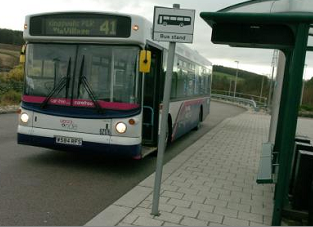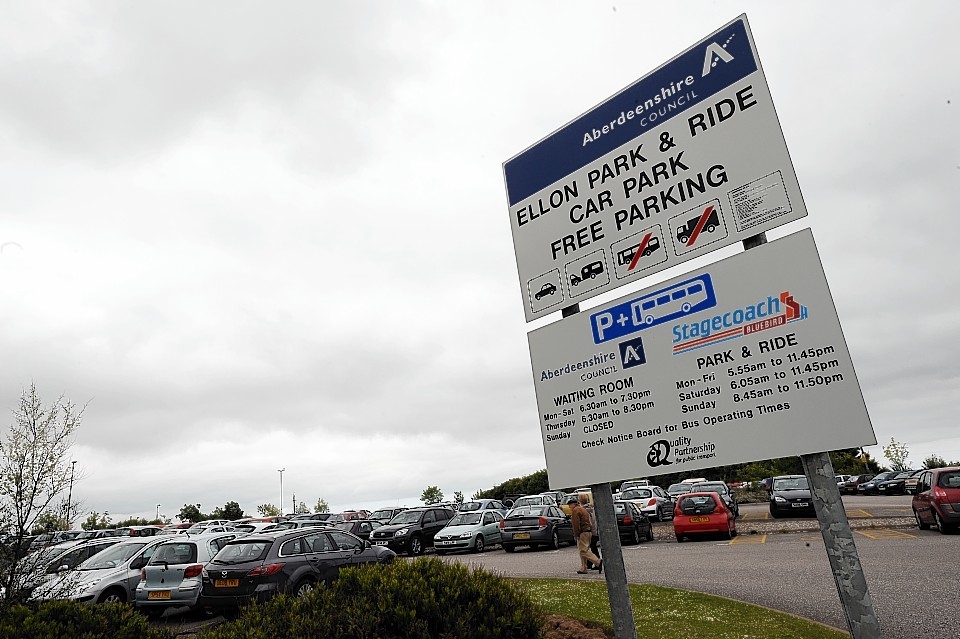Motorists are turning their backs on park and ride in Aberdeen – at a time when the city council is ploughing millions of pounds into new sites.
Passenger figures collated by the local authority show that usage of two facilities in the city dropped significantly over a five-year period, from 237,000 in 2008/09 to 165,000 in 2013/14 – a decrease of about 30%.
The Labour-led council administration announced the start of work on a £10million new park and ride at Dyce this week, with another earmarked for the south of the city.
Last night, motoring body the RAC said that “failings” in the current system should be addressed before more taxpayers’ money is invested.
Council finance convener Willie Young described it as a “chicken and egg” situation – but added that drivers habits would have to change.
Park and ride has been encouraged for a number of years now as a way of cutting congestion and providing commuters with an alternative to driving to work.
However, figures for the two sites in Aberdeen – at Bridge of Don and Kingswells – show usage has dipped significantly.
In the financial year 2008/09, 237,787 passengers were recorded, but numbers dropped to 174,476 in 2009/10.
The figures rose the following year to 201,172, with a further rise reported in 2011/12, when 213,599 people boarded.
But that number dipped to 180,380 in 2012/13 and again to 165,393 in 2013/14.
Professor Stephen Glaister, director of the RAC Foundation, said: “We’re all for sustainable, integrated travel, but how can a service be regarded as such when it has recorded a marked long-term decline?
“Something seems to be going wrong and perhaps the council should come to understand the failings in the current system before expanding it at significant expense to tax payers.”
Mr Young, Labour group secretary, said the authority was committed to promoting a “modal shift” away from car usage. He added: “It is a bit of a chicken and egg situation, but we have got to change people’s habits.
“We have been investing heavily in our hydrogen bus project and we are hoping that the quality of service and improved journey times will allow for people to start thinking about getting the bus.”
In a report by regional transport partnership Nestrans, the drop was partly blamed on a decision by bus operator First to alter its number 40 park and ride service from Kingswells.
The route was changed so that it terminated at Aberdeen Royal Infirmary in 2012, meaning passengers heading for the city centre had to change buses.
The subsequent fall-off in numbers was partially reversed when the number 40 service was fully reinstated in September 2013, with a 64% increase between April 2013 and April 2014.
However, those figures remain significantly below the mid-2012 numbers, prior to the service change. A spokeswoman for First had not responded a request for comment last night.
The exception in the north-east is the Ellon park and ride, which has shown a steady increase including a 2% rise from 2013 to 2014, according to council figures.
Aberdeenshire Council is also planning new “mini-hub” park and rides sites along the A947 Aberdeen to Banff road and the A93 Aberdeen to Braemar.
Nestrans set a target of reaching 400,000 park and ride passengers across the three existing sites in 2011.
Passenger usage has not exceeded 300,000 since 2007/08.
With more facilities planned in the north-east, however, Nestrans is aiming for 600,000 passengers by 2021.
The park and ride figures are in contrast to an increase in rail patronage in the north-east in recent years, which has risen dramatically.
Statistics for 2013-2014 from the Office of the Rail Regulator show that passenger numbers at the eight stations across Aberdeen and Aberdeenshire are up by an average of 7.83% on the previous year – equating to 5.8million entries and exits through stations.
That compares with a national increase of just 1.10%.
A senior official at north-east transport partnership Nestrans said yesterday 1,000 vehicles a day are being taken off roads in Aberdeen city centre thanks to park and ride sites.
Rab Dickson, transport strategy manager at the organisation, said that represents a “significant change” and would reduce congestion – even if usage figures are dropping at two of the three facilities.
He said: “There are still significant numbers of people using the park and ride sites – you are talking about 250,000 across the three sites.”
Mr Dickson said the drop in usage was a “complex” situation to explain, but said changes to bus services and new developments in the city centre have both contributed to the lower figures in recent years.
He said: “There has been a changing demand in terms of new shopping centres in the city centre and the car parks with them. But there has also been changes to bus services in that period of time, while some passengers are opting to use bus services other than the park and ride.”
Nestrans is now working with Aberdeen and Grampian Chamber of Commerce on a “barriers to buses” study, talking to local businesses and employees about what they want from public transport.
A further study is planedplanning a study on ways that the existing service can be improved.
Neil Greig, research and policy director at the Institute of Advanced Motorists (IAM), said new technology could help bus services to be more competitive.
He said: “We have to make it tempting and we have to make it of real benefit because there is a hassle factor. They have to be competitive with the private car which gives you a comfortable, door to door service.
“We need joined-up thinking with the bus companies, because if that doesn’t happen you undermine the whole process. It is things like simple ticketing, modern technology being used so you don’t have to have a ticket – think of the best systems with the Oyster cards or cashless payments. We have to get that type of new technology if you want to compete – people want significant time and cost savings.”
Mr Greig added that Aberdeen has a particular problem where many commuters are not going to the city centre, but heading towards workplaces in peripheral areas such as Altens or Dyce.

